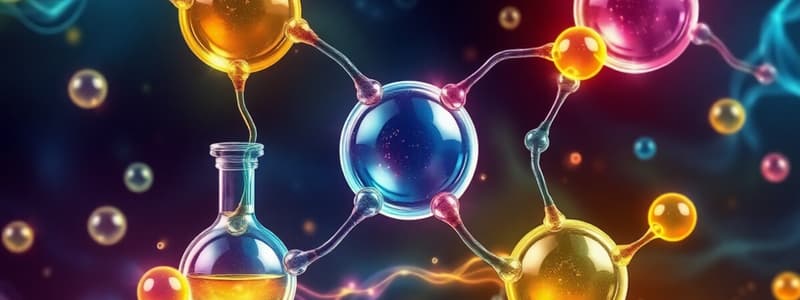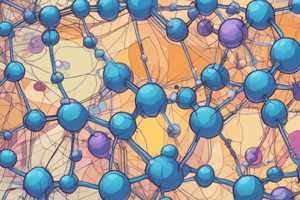Podcast
Questions and Answers
What is the primary characteristic of a Lewis acid?
What is the primary characteristic of a Lewis acid?
- It produces H+ ions in solution.
- It ionizes to produce OH- ions in solution.
- It accepts a pair of electrons. (correct)
- It donates a pair of electrons.
What defines a Lewis base in coordination chemistry?
What defines a Lewis base in coordination chemistry?
- It generates H+ ions when dissolved.
- It donates a pair of electrons. (correct)
- It accepts protons from acids.
- It is a proton donor.
How does the Arrhenius definition differ from the Lewis definition of acids and bases?
How does the Arrhenius definition differ from the Lewis definition of acids and bases?
- Lewis acids produce H+ ions in water.
- Arrhenius focuses on ion production in solution. (correct)
- Arrhenius defines acids based on electron donation.
- Lewis bases require OH- formation.
In a Bronsted-Lowry acid-base reaction, what role does H2CO3 play in the equation H2CO3 + H2O ↔ HCO3- + H3O+?
In a Bronsted-Lowry acid-base reaction, what role does H2CO3 play in the equation H2CO3 + H2O ↔ HCO3- + H3O+?
What is formed when a Lewis acid and Lewis base combine?
What is formed when a Lewis acid and Lewis base combine?
What best describes a dative or coordinate bond?
What best describes a dative or coordinate bond?
Which definition correctly identifies a Lewis acid?
Which definition correctly identifies a Lewis acid?
What is the definition of a ligand?
What is the definition of a ligand?
How is the coordination number of a metal ion determined?
How is the coordination number of a metal ion determined?
Which of the following definitions aligns with a Brønsted-Lowry acid?
Which of the following definitions aligns with a Brønsted-Lowry acid?
What characterizes a bidentate ligand?
What characterizes a bidentate ligand?
What determines the geometry around a metal ion in a complex?
What determines the geometry around a metal ion in a complex?
What does the oxidation number of a metal ion indicate?
What does the oxidation number of a metal ion indicate?
What type of bond is formed between the Fe3+ ion and CN- ion in the coordination complex?
What type of bond is formed between the Fe3+ ion and CN- ion in the coordination complex?
Which transition metal is mentioned as part of hemoglobin and myoglobin for O2 transport?
Which transition metal is mentioned as part of hemoglobin and myoglobin for O2 transport?
What is the main focus of coordination chemistry?
What is the main focus of coordination chemistry?
Which of the following metal complexes is mentioned as an anti-cancer agent?
Which of the following metal complexes is mentioned as an anti-cancer agent?
What is the oxidation state of the metal ion in the complex [Fe(CN)6]3-?
What is the oxidation state of the metal ion in the complex [Fe(CN)6]3-?
Which element is found in vitamin B12, playing a significant role in its biological function?
Which element is found in vitamin B12, playing a significant role in its biological function?
What is the coordination number of the complex ion [Fe(CN)6]3-?
What is the coordination number of the complex ion [Fe(CN)6]3-?
Which of these biomolecules is mentioned to contain zinc?
Which of these biomolecules is mentioned to contain zinc?
What type of ions do Lewis acids typically represent?
What type of ions do Lewis acids typically represent?
Which of the following electronic configurations correctly represents the Fe3+ ion?
Which of the following electronic configurations correctly represents the Fe3+ ion?
What is formed when Fe3+ reacts with 6CN-?
What is formed when Fe3+ reacts with 6CN-?
In the context of coordination chemistry, what are ligands?
In the context of coordination chemistry, what are ligands?
When determining the electronic configuration for transition metals, which electrons are removed first?
When determining the electronic configuration for transition metals, which electrons are removed first?
What is the total number of ligands in the complex ion [Fe(CN)6]3-?
What is the total number of ligands in the complex ion [Fe(CN)6]3-?
What charge does the coordination complex [Fe(CN)6]3- have?
What charge does the coordination complex [Fe(CN)6]3- have?
Which element's configuration is represented as [Ar] 4s23d2?
Which element's configuration is represented as [Ar] 4s23d2?
What is the oxidation state of platinum (Pt) in the complex ion represented by the equation Pt + 2 Cl- + 2 NH3 = 0?
What is the oxidation state of platinum (Pt) in the complex ion represented by the equation Pt + 2 Cl- + 2 NH3 = 0?
Which geometry is associated with a coordination number of 4?
Which geometry is associated with a coordination number of 4?
What type of bonding is characterized by the donation of a pair of electrons from a ligand to a metal ion?
What type of bonding is characterized by the donation of a pair of electrons from a ligand to a metal ion?
Which of the following coordination compounds is an example of square planar geometry?
Which of the following coordination compounds is an example of square planar geometry?
Which coordination number is most commonly associated with octahedral complexes?
Which coordination number is most commonly associated with octahedral complexes?
Which of the following statements about coordination compounds is incorrect?
Which of the following statements about coordination compounds is incorrect?
What is a common feature of first row d-block metal ions regarding their coordination number?
What is a common feature of first row d-block metal ions regarding their coordination number?
Which ligand is found in both examples for tetrahedral geometry?
Which ligand is found in both examples for tetrahedral geometry?
Which of the following ligands is classified as bidentate?
Which of the following ligands is classified as bidentate?
What type of ligand is ethylenediamine (en)?
What type of ligand is ethylenediamine (en)?
In the complex ion with the oxidation state of +3, what are the charges of the ligands involved?
In the complex ion with the oxidation state of +3, what are the charges of the ligands involved?
Which statement about the coordination number is true?
Which statement about the coordination number is true?
Which of the following options correctly identifies the donation pattern of monodentate ligands?
Which of the following options correctly identifies the donation pattern of monodentate ligands?
What is the primary characteristic of polydentate ligands?
What is the primary characteristic of polydentate ligands?
If each Cl- ligand has a charge of -1, what is the total contribution of the ligands in the complex with iron?
If each Cl- ligand has a charge of -1, what is the total contribution of the ligands in the complex with iron?
Which of the following statements about tridentate ligands is correct?
Which of the following statements about tridentate ligands is correct?
What does the oxidation state of a metal ion in a complex indicate?
What does the oxidation state of a metal ion in a complex indicate?
Flashcards
Lewis acid
Lewis acid
A substance that accepts a pair of electrons.
Lewis base
Lewis base
A substance that donates a pair of electrons.
Arrhenius vs. Lewis definitions
Arrhenius vs. Lewis definitions
The Arrhenius definition focuses on the production of ions in a solution, while the Lewis definition is broader.
H2CO3 in Brønsted-Lowry
H2CO3 in Brønsted-Lowry
Signup and view all the flashcards
Coordination compound
Coordination compound
Signup and view all the flashcards
Dative or Coordinate Bond
Dative or Coordinate Bond
Signup and view all the flashcards
Ligand
Ligand
Signup and view all the flashcards
Metal Complex
Metal Complex
Signup and view all the flashcards
Coordination Number
Coordination Number
Signup and view all the flashcards
Oxidation Number
Oxidation Number
Signup and view all the flashcards
Arrhenius acid
Arrhenius acid
Signup and view all the flashcards
Arrhenius base
Arrhenius base
Signup and view all the flashcards
Bronsted-Lowry acids and bases
Bronsted-Lowry acids and bases
Signup and view all the flashcards
Oxidation State
Oxidation State
Signup and view all the flashcards
Coordinate Covalent Bond
Coordinate Covalent Bond
Signup and view all the flashcards
Coordination Chemistry
Coordination Chemistry
Signup and view all the flashcards
Transition Metals
Transition Metals
Signup and view all the flashcards
Cisplatin
Cisplatin
Signup and view all the flashcards
Coordination compound formation
Coordination compound formation
Signup and view all the flashcards
Role of metal ion and ligand
Role of metal ion and ligand
Signup and view all the flashcards
Transition metal ion configuration
Transition metal ion configuration
Signup and view all the flashcards
What's a complex ion?
What's a complex ion?
Signup and view all the flashcards
Counter ions in coord. compounds
Counter ions in coord. compounds
Signup and view all the flashcards
Coordinate bond
Coordinate bond
Signup and view all the flashcards
Oxidation number in coordination compounds
Oxidation number in coordination compounds
Signup and view all the flashcards
Oxidation State of Metal Ion
Oxidation State of Metal Ion
Signup and view all the flashcards
Geometry of Complex Ions
Geometry of Complex Ions
Signup and view all the flashcards
Complex ion
Complex ion
Signup and view all the flashcards
Coordination Complex
Coordination Complex
Signup and view all the flashcards
Monodentate Ligand
Monodentate Ligand
Signup and view all the flashcards
Bidentate Ligand
Bidentate Ligand
Signup and view all the flashcards
Oxidation State of the Metal Ion
Oxidation State of the Metal Ion
Signup and view all the flashcards
Geometric Isomer
Geometric Isomer
Signup and view all the flashcards
Optical Isomer
Optical Isomer
Signup and view all the flashcards
Study Notes
Fundamentals of Medicinal and Pharmaceutical Chemistry - Coordination Chemistry
- Learning Outcomes:
- Define dative/coordinate bonds.
- Define Lewis, Arrhenius, and Brønsted-Lowry acids and bases.
- Define coordination compounds.
- Recall examples of Lewis acids and bases.
- Define ligand and metal complex.
- Determine coordination number and oxidation number of a metal ion in a metal complex.
- Identify/predict the geometry around a metal ion.
- Define ligand denticity.
- Recall and identify examples of monodentate and bidentate ligands.
Recommended Reading
- General Chemistry - The Essential Concepts by Chang and Goldsby 7e
- Chapter 20
- Chapter 10, Section 10.1 on molecular geometry
Ionic Bonding
- In Ionic bonds, electrons are lost or gained forming ions.
- The ionic bond is the attraction between the positive and negative ion.
Covalent Bonding
- The octet rule is achieved by sharing electron pairs in the middle.
Dative (Coordinate) Bond
- Fe³⁺(aq) + 6CN⁻(aq) → [Fe(CN)₆]³⁻(aq)
- Electrons from the CN⁻ species are donated to the Fe³⁺ metal ion.
Coordination Compounds
- Coordination compounds contain one or more metal ions, usually transition metals, surrounded by ligands.
What is Coordination Chemistry?
- Coordination chemistry studies the interactions between transition metals and molecules or ions.
- A coordination compound contains one or more metal ions surrounded by ligands.
Why Study Coordination Chemistry?
- Many biomolecules contain transition metals playing key roles.
- Examples: Vitamin B12 contains Co, metalloenzymes contain Zn or Fe (e.g, hemoglobin, myoglobin), responsible for oxygen transport and storage.
- Transition metal complexes can be therapeutic agents (e.g., Pt complexes as anti-cancer agents; Gold complexes as anti-arthritic agents).
What are Transition Metals?
- Transition elements located in the periodic table.
Structure of Cisplatin
- Used to treat various types of cancers (e.g., testicular, lung, ovarian).
- Lewis acid and bases
What are Lewis Acids and Bases?
- Lewis acid: Accepts electron pairs (electron pair acceptor).
- Lewis base: Donates electron pairs (electron pair donor).
Arrhenius Definitions of Acids and Bases
- Arrhenius acid: Ionizes to produce H⁺ in aqueous solution.
- Arrhenius base: Ionizes to produce OH⁻ in aqueous solution.
Brønsted-Lowry Acids and Bases
- Brønsted-Lowry acid: Proton (H⁺) donor.
- Brønsted-Lowry base: Proton acceptor.
How do Lewis Acids and Bases Combine to Give Coordination Compounds?
- Lewis acid (metal ion) accepts electron pairs from Lewis bases (ligands).
Recall Electronic Configurations of First-Row Transition Elements
- Electronic configurations of Sc, Ti, V, Cr, Mn, Fe, Co, Ni, Cu, and Zn are listed.
Oxidation State of the Metal Ion
- Determining the oxidation state of the metal ion in a coordination compound.
Ligand Denticity
- Monodentate: 1 donor atom
- Bidentate: 2 donor atoms
- Tridendate: 3 donor atoms
- Tetradendate: 4 donor atoms
- Hexadentate: 6 donor atoms
- Polydentate: 2 or more donor atoms
- Examples: Monodentate ligands (e.g., H₂O, H₂S, CH₃OH, CH₃SH, F, OH); Bidentate ligands (e.g., oxalate ion (ox), ethylenediamine (en), 2,2'-bipyridine (bpy)).
Geometries in Complex Ions
- Coordination Number:
- 2: Linear (e.g., [Ag(NH₃)₂]⁺)
- 4: Tetrahedral (e.g., [Zn(NH₃)₄]²⁺, [FeCl₄]⁻); Square planar (e.g., [Ni(CN)₄]²⁻)
- 6: Octahedral (e.g., [Fe(H₂O)₆]³⁺)
Examples of Coordination Complexes
- Examples of neutral complexes and complex ions are described.
Studying That Suits You
Use AI to generate personalized quizzes and flashcards to suit your learning preferences.




